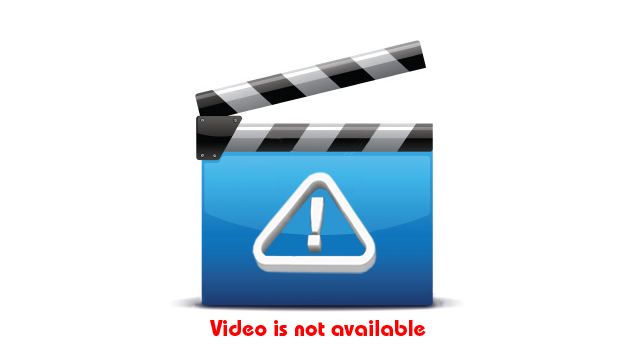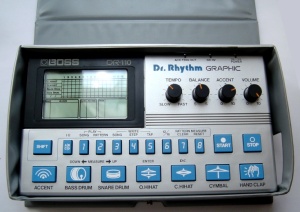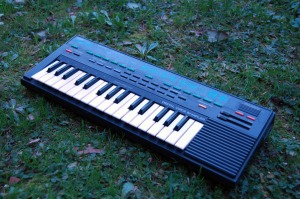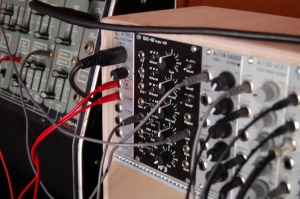
retrò & vintage
drum machines, retrò & vintage
BOSS DR-110 review
by synthvibrations • • 0 Comments
This little cute box is a fully analog drumachine with a graphic sequencer.
The unit is really tiny and portable and offers six sounds plus accent.
The sounds are:
- Accent
- Bass drum
- Snare drum
- Open hihat
- Closed hihat
- Cymbal
- Hand clap
There are four knobs :
- Tempo (fast-slow)
- Balance
- Accent
- Volume
The tempo is controlled by the knob but the machine does not display the value of the BPM.
The balance act as a mix between the drum & snare and hats & cymbal.
Accent controls the “accented”sound , in fact it does not only affect the volume of the percussion accented but also the timbre.
Volume is the Master Volume.
The sounds are the classic analog drum sounds of Roland CR/TR series.
The kick is really similar to the one of the TR808 and of the CR8000 , fat and punchy, much deeper and full compared to the TR-606.
The snare is really snappy and can be a cross between a TR808 and a TR606.
Hats and cymbal resembles the TR606, while the clap is a classic tr808 one.
Programming is similar to the CR series with the pause/trig style , but is far easier than on CR78 or CR8000 because here we have a disply with the programming grid!
The display is really similar to the one on the TR707 or TR727 , all the elements are displayed and is like programming on cubase or any other software sequencer.
The START acts as TRIG and the STOP as PAUSE.
The Accent acts also as TRIG OUT INST.
The downside of this machine is the absence of a clock in , but many modifications are available to install a sync in or even midify the machine.
All in all an awesome little beast that comes really cheap!
modulars, retrò & vintage, synthetizers
The Korg MS Serie
by synthvibrations • • 0 Comments
At the end of the 70s the japanese synth market became very busy.
The leading brands were Korg , Yamaha and Roland.
While Yamaha’s target was mainly on low budget prepatched monosynths users, Roland and Korg were on the low budget side but with an interest in producing low cost modulars for the masses.
Roland at the age had the SH serie that targeted prepatched synth users while the system 100 was towards low budget modulars/semimodulars and the System700 was a Pro-Studio product.
Korg had a different approach, the MS and PS series were mainly mono and poly semimodulars that could be used as standalone prepatched instruments as complex systems linked together.
The MS serie was composed by the MS10 (the little 1 vco, 1 vcf, 1env basic synth), the MS20 (the 2 VCO bigger brother with many added features), the MS50 (the modular expander, full of the less common modules on synths of that period) and the SQ10 (3 track sequencer).
Even if the components used on MS synths were mainly the same, due to different electronic construction the three models have slight different sounds.
The MS10 is considered by some the more aggressive as filter behaviour (compared to the MS20) and because of the presence of pulse width modulation (absent on the MS20).
The MS20 is the more versatile of the three as can work as a synth (with lots of features), efx processor, and can be controlled even with audio signals!
The MS50 is the only real modular of the serie, it must be patched to produce sounds, and has a vast array of particular features as 2 ringmodulators, the vc lfo, the vco with multiouts, logic modules, the volt-meter, etc…
While the MS10 is a “straight” synth if used standalone, the MS20 is a good soundesign machine but it is a real awesome modular when used in junction with MS50 and the SQ10.
The MS50 can be used to produce linear or exp FM, or to fatten up the sound, with 3 vco, 3 filters 4 env etc this little modular is really awesome!
Compared to the “high end” modulars/semimodulars of the period , like the ARP 2600, EMS Synthi, Moog Systems, the MS serie has a more “noisy”and less harmonic carachter, but while back in that days were mainly considered low budget modulars, now are considered great sounding machines because the approach at making music (especially electronic music) is really changed.
Every electronic music producer uses or has used an MS in his career.
In the late 70s and early 80s MS10 and MS20 were widely used by new wave synth pop bands as O.M.D. , Human League, Depeche Mode.
During the 90s every techno , electronic , producer used one or more than one.
Just to name a few Aphex Twin uses 4 MS20 , Autechre uses MS20 and MS10, Coldcut used extensively the MS20 , Mr.Oizo (MS20) , Portishead (MS20 & MS50),Daft Punk, Chemical Brothers…
Later I’ll analize deeper the MS20 & MS50 combo, stay tuned!
game consolles and circuit bending, music, retrò & vintage
Daft Punk played with the CASIO SK5
by synthvibrations • • 0 Comments
game consolles and circuit bending, retrò & vintage, synthetizers
Yamaha VSS-30 (8bit sampler) review
by synthvibrations • • 1 Comment
Cheap is not always bad, and toy keyboards are not always and only toys.
This is the case of the Yamaha VSS30, a toy keyboard from the late 80’s, that’s today a widely used musical intrument for experimental musicians and not a child/school keyboard.
The reasons why the vss3o is so appreciated for particular musical genres are its sound and the manipulating capabilities.
The engine of the keyboard is an 8bit sampler with synthesis capabilities, that can sample and resample layering sounds.
All the edit is done with buttons on the front panel without any menu , and the variations are realtime effective.
There is :
- ADSR Envelope fore the volume of the sound
- Loop function
- U-turn (plays the sample fwd and rew)
- Reverse (to reverse the sample)
- ECHO (is a”envelope effect”, like a long decay-release)
- Fuzz
- Frequency Modulation
- Amplitude Modulation
- Vibrato
There are 12 preset sounds that can be manipulated with efx (adsr, echo, fuzz, fm, am , vibrato):
- Piano
- Harpsicord
- Banjo
- Vibes
- Marimba
- sample
- Crystal
- Strings
- Jazz organ
- Brass
- Clarinet
- Galaxy
The preset sounds are samples of DX7 presets , I presume, from the sound that is quite synthetic and not natural.
But the more gorgeous power is in the capability of mangling the sample with the efx/synthesis.
Every effect is editable with the data entry buttons.
So as the adsr can shape the loop and u-turn can create some really particular loop textures if used as pads, and the FM and AM can go from low tremolo/articulated low pitchmodulation , to fast tremolo and vibratos/FM sounds.
The overwrite function layer the sample in memory with incoming audio material creating a new sample.
All in all this is a little but awesome LO-FI experimental machine, as it’s the only toy keyboard that can do all these things without modding (as the VSS200, a larger version of the VSS30).
The sound is warm, “pixelated”, lo-fi, and every sample sounds really different from the source.
It’s perfect for IDM, experimental music, but also for pop or mainstream as many professionals use it in their recordings like Sigur Ros, Portishead, Trent Reznor, Autechre, Bjork.
retrò & vintage, synthetizers
Eurorack modular vs Roland System100 Mod-102 (Part 1)
by synthvibrations • • 0 Comments
As I described some days ago , I’m building a little modular in eurorack format to have a little versatile synth to make modular sounds easy, and to expand my system of vintage semimodular synths:
- Roland System100 MOD-102
- Korg MS-20
- Korg MS-50
- Korg PS-3100
The Korgs work well altogether as they use the same korg “standars” as 1/4″ plugs, hz/volt , etc.
The system is well balanced and is very versatile , there are no tuning problems and connections between one module and the other has no need of attenuators and result open to every use.
The Roland System 100 is quite different, it uses 3,5mm plugs, 1volt/oct and is quite difficult to make it interact with the Korgs even because the sound of the Roland is “stronger”.
After analizing different solutions (the first was to buy the other parts : mod 101 the keyboard, the sequencer and the mixer, while the second was to buy a System100m…) I decided to buy an eurorack to have a synth easier to control with computers and midi devices , more stability and however the freedom to build a synth choosing every part.
The result is, as I described, a synth with basic elements that are quite different from the “new analog” I own (DSI Evolver desktop and Studio Electronics ATC1 and SE1), but quite versaatile for a wide range of sound including FM modulations.
The first thing I tried is the interfacing between the Eurorack and the Roland and I was surprised they interact very well .
The Midi-CV interface works very well with the System100 too (I use a Kenton Pro 2000 for it, usually..).
The first thing I tried was to compare the Roland VCO with the MFB VCOs and I was quite surprised.
The Roland is really thick on the lower frequencies, and the square waves are awesome , but the MFB is really good too and they have a similar sound in many ways.
The MFB is less deep , especially when you hear in A->B comparison , and a little darker on the highest frequencies, but does a really a well job fattening the System100 sound without sounding different.
What makes the BIG difference is the Roland Filter.
Using only the MFB VCO in the roland path , with the roland VCO with zero volume, the result is amazing.
The VCO sound smooth and rich, really fat on the lower range and really harmonic and “creamy” in the higher register.
The big difference is evident in the lead sounds, they sound smooth with big carachter and warm sound without being harsh or disturbing but always rich of mid and high harmonics.
As the resonance grows the sound became quite acid (the typical roland filter carachter) but with growing harmonics, and a massive warm sound.
Then I tried to use the MFB dual ADSR to compare the behaviour of the two type of env and even here the different is evident.The Roland one is FAST and SNAPPY but always “rounded”, more musical, and gives the synth the classic Roland touch.
The MFB ENV is really fast, maybe faster than the Roland, but also more angular, with the attacks at zero makes a “ping” sound at the trig of the note.
Maybe the voltage that this env produce is higher and should be attenuated to get more musical results, even if the different behaviour is really interesting to get different result.
The first thing done was a sequenced upright bass that sounded really awesome.
I did the same sound using only the eurorack and the sound was similar but more enarmonic, the reason is without any doubt the different between the two filters.
music, retrò & vintage, synthetizers
Squarepusher played with Roland MC-202
by synthvibrations • • 0 Comments
retrò & vintage, synthetizers
Roland MC-202 MicroComposer
by synthvibrations • • 0 Comments
It all started with the Roland TB-303, the first cheap alternative to the bassplayer for the pub guitar player…
After the 303 Roland decided to create a more versatile and not limited only to basslines, a micro composer!
The MC-202 is like to instruments in a little plastic box.
The synth is derived from the Roland SH-101 and the sequencer is like a little MC-4 but only with 2 track (against the 4 of the MC-4) , its name could be MC-2… that’s why MC-202!
The synth itself its quite simple but really versatile for the task of making arpeggios, basslines, sequencered blips and blops, and sequenced leads.
There is a single VCO with SUB that can produce a saw and a pulse (with modulation)and the SUB (a square wave 1 or 2 ocyave lower or a pulse 2 octv lower).
The three wave are mixed by the MIXER section , than filtered and after the the filter we have the VCA (amplification) and the ENV.
The FILTER section has Cutoff, Resonance, Env (env amount) , Mod (LFO amount) , KYBD (keyboard tracking).
The filter is a 24dB with resonance with the classic analog roland carachter and sound, it can act quite rounded and smooth and get acid when you turn up the resonance.
With the reso at max the filter prduce a SINE wave that can be played by the keyboard using the KYBD at max.
The VCA is quite simple and has only a switch, ENVor GATE.
With the Env is switched the env shape the sound and the accent controls the volume, while when switched to gate the synth plays only when the key is pressed and loose the accent on volume, but ois useful for sequenced sounds when you want the ENV to control the filter only.
The ENV is a simple adsr that acts really snappy and with a fast attack, really great for bass and percussive timbres.
The LFO is quite simple, has only triangle wave with delay, to let the vibrato grows after a while.
The sound of the machine is a cross between a TB-303 and an SH-101, maybe the MC-202 can get more aggressive /acid than the 101 while the 101 has a just a little more sub on the bass end when used to generate sub basses, but the sound is more or less the same.
Maybe the only differences are made by trimpots regulations and not by any difference in electronic design.
The other part of the machine is the SEQUENCER.
The seq is different from the 303, is not a pattern style but a linear sequencer (just like the MC-4).
This difference let the MC-202 creates longer and more complex sequences , as it has a deeper editing on note durations, gates etc, while it mantains the ACCENT (for FILTER and AMP, and it can be choosen individually, so 2 accent!) and the GLIDE (here named PORTAMENTO) with its time knob (on the 303 the time is fixed).
Making a sequence on the MC-202 is harder than on the 303 if you want to get exactly what you have in mind.
Vince Clarke (former member of Depeche mode, Yazoo and Erasure and famous user of old Roland sequencers as MC-8, MC4 and MC-202) is described as one of more trained user as he could compose all the song without hearing the music, just pressing the buttons and than pressed play and BaaaM! the song was perfect!!
Indeed the programming of the sequencer is not the easiest, and it takes time to get into it, but it can create really great results , difficult to get with other gear.
The fact that there is a little LCD display on such a cheap old intrument means something…
I forgot to say that the sequencer has 2 identical tracks with CV-GATE outs to play external analog synths and a DIN SYNC IN and 2 DYN SYNC OUTs and tape in and out to be syncronized to other machines or tape recorders or DAW.
A classic touch of the 80’s is that the MC has no memory for the sequencer so you have to save and load your seqnces with the TAPE DUMP (you can use a cassette recorder or you can record the data sound directly into your computer to have a far more practical collection of sequences to load..)
The MC-202 has been used mainly by all the electronic producers of the last 25 years, even if it’s not as famous or hyped as the 303.
From Aphex Twin to Autechre, Human League, Sabres of Paradise, 808 STATE, KID606 etc…
This is a great machine, and its sequencer is really a part of the strong carachter of the MC but there is also a software that can generate the data sound to load into your MC to program the sequence on your computer and than load it into the MC to get the best of both worlds.
Here is the link :








